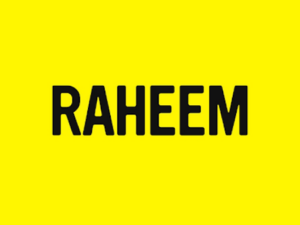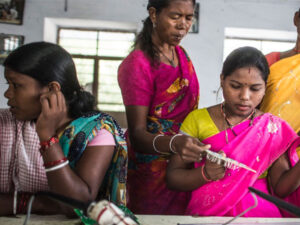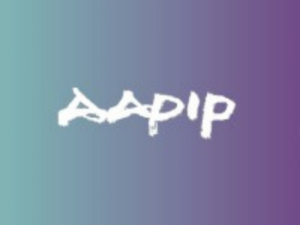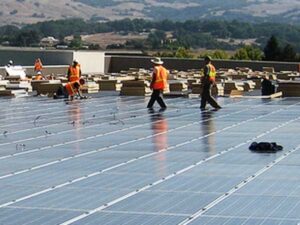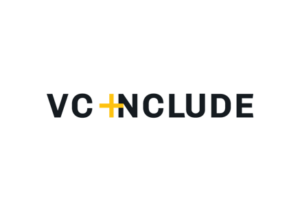VisionSpring works to expand access to affordable eyeglasses and vision screenings so that nonprofits, social entrepreneurs, government agencies, and corporate clients can expand vision health in their communities.
Ella Gudwin of VisionSpring spoke with Ambika Samarthya-Howard on November 2, 2023. Click here to read the full conversation with insights highlighted.
Ambika Samarthya-Howard: Could you please start by introducing yourself? I’d also love to hear what it’s like to be CEO Of the organization while the current CEO [Jordan Kassalow] is still there.
Ella Gudwin: I’m Ella Gudwin, and I came in as CEO in 2015 with 20 years of background in global health and emergency response.
Jordan [Kassalow] founded VisionSpring, so he came from a technical point of view at the beginning, as an optometrist, and he still plays a role in the organization as our most senior technical advisor on anything to do with eye care. Jordan has also been a student of social entrepreneurship since the beginning. VisionSpring was founded as a social enterprise in 2001, and when I came in it was to figure out how VisionSpring was going to be a social enterprise into the future, because there are many ways to be a social enterprise. Jordan kept responsibilities that are associated with fundraising and being an ambassador for the organization and for the cause. And Jordan serves as the vice chairman of our board.
Ambika Samarthya-Howard: Can you tell me more about what you do?
Ella Gudwin: I’ve worked across a wide variety of interventions, including reproductive health, diabetes, childhood malnutrition, and emergency health in the context of emergency response.
My prior organization had a fee-for-service clinic in El Salvador that saw one hundred thousand people a year, and we had a little optical shop, so I had done a bunch of analysis on revolving funds and earned revenue streams in that context. I was personally really interested in jumping to the front line of where I thought international development was going, which was through the social entrepreneurship lens.
I had been in an organization that specialized in gifts in kind, so we were very literally giving band-aids away. I had worked on a broad range of interventions and was intellectually really fascinated by two things. One was how, having been in global health for 20 years, I didn’t know that this very simple intervention of eyeglasses could have so many outcomes and so many benefits. It is an under-deployed tool in the toolbox. The other was the idea that the North Star is eyeglasses because they can increase functioning, productivity, and income. We reformed and reshaped our theory of change at the beginning, and that vision correction is a driver of multiple Sustainable Development Goals: livelihoods, no poverty, road safety, education, gender [equity], and financial inclusion. People are locked out of the mobile economy when they can’t read their phones.
Then the business models themselves have to serve the purpose. If we were singularly focused on functioning productivity and income through vision correction, then what were the business models that could scale and grow to meet the size of the problem? That’s the piece that we’ve been wrestling with over the years. We started as 90 people, and now we’re 370 people. We were in two countries, and now we’re operating in eight countries. We were making $3 million and now we’re earning $16 million, and most importantly, we were correcting the vision of 400,000 people a year and now this year it will be 1.9 million people.
Ambika Samarthya-Howard: What about your approach do you think has allowed you to scale in that way? Can you describe your economic model a bit?
Ella Gudwin: VisionSpring does two things. We get people their first pair of glasses by bringing vision correction into communities where people earn, learn, and play. It’s working in factories, cooperatives, and farming communities, and getting people with near vision correction requirements into glasses. That’s B2C [business to consumer], and the second model we use is B2B [business to business], where we leverage our supply chain to provide durable quality eyeglasses for mission-aligned organizations, like other hospitals, clinics, governments, NGOs.
Ambika Samarthya-Howard: What’s something that hasn’t been working well for you, that you feel like people could maybe learn some lessons from? Or maybe there are things that went very smoothly that other people could learn from.
Ella Gudwin: We did a very big pivot in 2014, and we wrote a 30-page case study with Duke about it, to open a discussion about the failures that we’d had and how we reorganized. So there are a couple of pieces. If I had to counsel myself again, or others, [as part of] an organization that’s growing, I would say one thing we did well was to invest in technology early and in your platforms early.
We are in Salesforce, and it is the backbone for our data capture, for all of our metrics, and for our sales pipeline, as well as for fundraising.
We’ve customized that, and we’ve invested in SAP [Systems, Applications, and Products] as our financial platform, which allows for all of our eight countries to be on the same platform. It also allows us to do financial consolidation, but most importantly, it allows for country-level leaders and department leaders in each country to have responsibility for their budgets. That decentralizes power out of the “headquarters team” or the global shared services team, and puts a lot more decision-making in proximity to the communities that we’re serving.
As we were growing, the US team went from seven to 12 people, but the rest of the organization went from 90 to 370 [people]. So 97% of our team is in country, and we decentralized leadership as we grew. I would definitely do that again.
If I counseled myself again, I would say just because I was good at fundraising doesn’t mean that I should have held onto it for so long. I would’ve hired more senior fundraising support earlier. We probably would’ve registered in a couple of countries earlier. It’s not as complicated as it’s made out to be.
I also think not underestimating the grind on the mid-level management team, and investing in people and in the learning and development agenda, is crucial. It’s the mid-level managers who really experience the grind of growth, and their roles get more complicated as we grow, so we need to be much farther ahead of their growth trajectories to support their upscaling, and also to watch for burnout.
Ambika Samarthya-Howard: What do you think are some of the limitations of their approach or the work the organization is doing? Have you encountered challenges that you can’t overcome?
Ella Gudwin: Yes, and that’s where coalition work becomes important. VisionSprings Alliance is an independent organization that does systems stage work. We’re also involved in coalition work that’s at the UN level with the World Health Organization. We can’t bring down trade barriers by ourselves. The world of eyecare is held captive by ophthalmologists and optometrists, and half the problems of the world can be solved with reading glasses. They’re just magnifying glasses; they’re over the counter. You do not need an eye exam. You need a visual acuity assessment, but you don’t need a comprehensive eye exam for that problem. We can train pharmacists and community health workers and plenty of other lower-level people to do that work, but we need global consensus on a task-sharing framework from the ophthalmologists to the optometrists to the technicians to the pharmacists.
Ambika Samarthya-Howard: What is a task-sharing framework, what does that mean?
Ella Gudwin: Imagine when you or I go into a doctor’s office. A nurse will take our BP, they’ll take our weight, they’ll ask us questions, and then the actual physician will pick up the core elements of the exam. The physician doesn’t need to do the entire exam. That’s an example of task-sharing within a medical office.
A community health worker can do a visual acuity assessment, and if somebody fails the distance screen, and they can’t see in the distance, then they get referred automatically to an optometrist. Maybe they have a cataract, or maybe they have something else. The community health worker can see if somebody has redness or an infection. They can’t solve it, but they can send people on for referral.
We don’t send people to a dentist to get a toothbrush. We do not need to send people to an optometrist or an ophthalmologist to get reading glasses.
Ambika Samarthya-Howard: That makes a lot of sense. One of the things that we talked about in terms of the future was around the MacKenzie Scott Grant and how that’s really helped. Maybe we could talk a little bit more about not just that grant, but where you are going and how the grant enables you to do that.
Ella Gudwin: The funds are unrestricted, but we earmarked the funds internally. So we received $15 million, and we put 60% against a scaling plan, which is called our livelihoods and focus, which I can talk more about. Then 25% is for internal capacity building so we can make sure the infrastructure is strong enough for the next level of growth. Then we have a slice that is for innovation, whether it’s new model development or technologies or solving for demand generation. We also have a slice for sector building, which is around collaborative efforts. Those guideposts help a lot in terms of thinking about how we allocate the money over the next five years. We did put ourselves on a spend-down plan.
In terms of where we want to go, it’s livelihoods and focus. If we look at eyeglasses, one billion people need eyeglasses, and the WHO [World Health Organization] has set a goal for the effective coverage of refractive error with eyeglasses. In the communities that we serve, as little as 20% of the people who need eyeglasses have them.
It’s basically a new product introduction strategy for a 700-year-old technology. New product introduction strategy starts with identifying the early adopters. You can spread eyeglasses all around like fairy dust because a billion people need glasses, and you’ll always find somebody who needs glasses. But if you have limited resources, how do you get maximum lift? Where is a social enterprise model the most relevant? You need to have some purchasing power and you need to have a little bit of eye care infrastructure because some of the problems do require high-level services, but you need the early adopters.
Who are the early adopters? It’s near vision agriculture. We often think about glasses as being for people who are literate, and we’re very focused on glasses for tasks. If you look at near vision intensive agriculture, it’s tea, because they’re picking two leaves and one bud, and they’re for quality. Coffee because of all the hand sorting and the other processing. And cocoa, which is hand-pollinated with a working surface of a centimeter. Vanilla is also hand-pollinated. They’re very near vision intensive.
Those take you into communities that are geographically dense. 70% of them are smallholder farmers. They’re responsible for employment in their states and countries, but they’re also really responsible for large portions of the GDP. They’re also politically important populations. And then you layer into that micro-enterprise, and look for [the most productive areas]. Let’s say in Assam, the largest tea growing area outside of China, 12 districts produce the most tea. If you layer in which districts have the greatest number of micro-entrepreneurs and artisans, that takes you into seven districts. Once we go into the district, we can be for the whole district, but we are in an early adopter district.
Then we can affect a tipping point by saturating the community with eyeglasses through vision screening. We can normalize wearing eyeglasses. If you ask people who need glasses why they don’t have them, about 50% of the people are self-conscious about wearing glasses. They don’t want to dip them on their nose, they don’t want to be the only person wearing glasses. They don’t want black glasses, they want gold glasses. They don’t want to be old.
All versions of self-consciousness because glasses just aren’t in the community. So the MacKenzie Scott Grant, to finally answer the question, is the down payment for us to make the investment. We want to be able to get 10 million tea, coffee, and cocoa farmers, and their neighboring artisans, into eyeglasses. That would unlock more than a billion dollars worth of income-earning potential at the household level because eyeglasses can increase income for first-time wearers by 34%. We have allocated $9 million in MacKenzie Scott Grant funds to the effort, which puts the baseline capability into the communities that we’ve identified. Then we need to bring in an additional $61 million to fill the gap. That’s all.
Ambika Samarthya-Howard: I’m sure you can do it. My last question is do you have any other insights that you haven’t touched on that you think are important to share? Any teachable lessons?
Ella Gudwin: I do, and this is related to the MacKenzie Scott Grant, and the finance and the funders in the philanthropic sector. A lot of people were asking the philanthropic sector, are you going to be like MacKenzie Scott? Will you do unrestricted giving? Will you do trust-based philanthropy? Those are relevant questions, but I think it’s missing the opportunity because even if inside the school portfolio there are 40 of us who have MacKenzie Scott funds, most of us have scale-ready plans. Most of us have some version of what I just described.
So there’s a natural experiment happening, which is we either all show a little bit of incremental gain with our money, and then we go back to incremental growth and the status quo. Or we surface the opportunities in saying there’s a lot of scale-ready organizations that are vetted, have track records, have a down payment, and there’s leverage. There’s an opportunity for philanthropy, and for other funders to come in to get outsized impact. So I wouldn’t say that the challenge to the philanthropic community is where you fund like MacKenzie Scott. I think the actual challenge to the philanthropic community is whether they will meet the moment for outsized impact knowing that the MacKenzie Scott funds are there as a down payment, and go for the leveraged opportunity.
Ambika Samarthya-Howard: Is there anything else you want to add?
Ella Gudwin: I think a lot of organizations go through really bumpy founder transitions. Ours was not, and a lot of that is a testament to Jordan. When I first came in, he and I were meeting every week, and we were very clear about the stuff that I was taking over early and the stuff that I would take over later. At a certain point there’s ego, and the role of ego matters a lot, but Jordan happens to be a particularly low ego dude.
You can’t underestimate communication, [as there are often some questions] around what the organization is, and why the transition is happening. Is the transition happening because there was mismanagement? Our transition was a moment when the organization was ready for a different skill set than Jordan’s skill set and what he wanted to focus on. I didn’t come into an organization that needed fixing. We were at a transition period, and we needed to reframe our growth plan.
Ambika Samarthya-Howard: Thank you for talking with me today.
Click here to read the full conversation with insights highlighted.
Ambika Samarthya-Howard (she/her) is the Solution Journalism Network’s Chief Innovation Officer: She leads on innovation and technology, leverages communication platforms for the network strategy and creates cool content. She has an MFA from Columbia’s Film School and has been creating, teaching and writing at the intersection of storytelling and social good for two decades. She has produced content for Current TV, UNICEF, Havas, Praekelt.org, UNICEF, UNFPA, Save the Children, FCDO, Global Integrity and Prism.
* This interview has been edited and condensed.
Find other organizations working to expand access to care.


